Cho tam giác ABC có G là trọng tâm, I là điểm thỏa mãn \(\overrightarrow {AI} = - \dfrac{1}{2}\overrightarrow {AC} \). Điểm M thỏa mãn \(\overrightarrow {AM} = x\overrightarrow {AB} \) (\(x\) là số thực). Tìm \(x\) để M, G, I thẳng hàng.
M, G, I thẳng hàng \( \Leftrightarrow \) tồn tại số k để \(\overrightarrow {IG} = k\overrightarrow {IM} \)
\(\begin{array}{l}\overrightarrow {IG} = \dfrac{1}{3}\left( {\overrightarrow {IA} + \overrightarrow {IB} + \overrightarrow {IC} } \right) = \dfrac{1}{3}\overrightarrow {IA} + \dfrac{1}{3}\left( {\overrightarrow {IA} + \overrightarrow {AB} } \right) + \dfrac{1}{3}\left( {\overrightarrow {IA} + \overrightarrow {AC} } \right)\\ = \overrightarrow {IA} + \dfrac{1}{3}\overrightarrow {AB} + \dfrac{1}{3}\overrightarrow {AC} = \dfrac{5}{6}\overrightarrow {AC} + \dfrac{1}{3}\overrightarrow {AB} \end{array}\)
\(\overrightarrow {IM} = \overrightarrow {IA} + \overrightarrow {AM} = \dfrac{1}{2}\overrightarrow {AC} + x\overrightarrow {AB} \)
Do đó \(\dfrac{5}{6}\overrightarrow {AC} + \dfrac{1}{3}\overrightarrow {AB} = k\left( {\dfrac{1}{2}\overrightarrow {AC} + x\overrightarrow {AB} } \right) = \dfrac{k}{2}\overrightarrow {AC} + kx\overrightarrow {AB} \).
Đồng nhất hệ số ta được \(\left\{ \begin{array}{l}k = \dfrac{5}{3}\\x = \dfrac{1}{5}\end{array} \right.\)
Cho tam giác ABC, lấy các điểm M, N trên cạnh BC sao cho BM = MN = NC. Gọi \({G_1},\,\,{G_2}\) lần lượt là trọng tâm tam giác ABN, ACM. Biết rằng \(\overrightarrow {{G_1}{G_2}} \) được biểu diễn theo hai vecto \(\overrightarrow {AB} ,\,\,\overrightarrow {AC} \) dưới dạng \(\overrightarrow {{G_1}{G_2}} = x\overrightarrow {AB} + y\overrightarrow {AC} .\) Khi đó x + y bằng:
Ta có:\({G_1}\) trọng tâm tam giác ABN \( \Rightarrow \overrightarrow {A{G_1}} = \dfrac{2}{3}\overrightarrow {AM} .\)
\({G_2}\) trọng tâm tam giác ACM \( \Rightarrow \overrightarrow {A{G_2}} = \dfrac{2}{3}\overrightarrow {AN} .\)
\(\begin{array}{l} \Rightarrow \overrightarrow {{G_1}{G_2}} = \overrightarrow {{G_1}A} + \overrightarrow {A{G_2}} = - \dfrac{2}{3}\overrightarrow {AM} + \dfrac{2}{3}\overrightarrow {AN} \\ = - \dfrac{2}{3}\left( {\overrightarrow {AB} + \overrightarrow {BM} } \right) + \dfrac{2}{3}\left( {\overrightarrow {AC} + \overrightarrow {CN} } \right)\\ = - \dfrac{2}{3}\overrightarrow {AB} - \dfrac{2}{3}.\dfrac{1}{3}\overrightarrow {BC} + \dfrac{2}{3}\overrightarrow {AC} - \dfrac{2}{3}.\dfrac{1}{3}\overrightarrow {BC} \\ = - \dfrac{2}{3}\overrightarrow {AB} + \dfrac{2}{3}\overrightarrow {AC} - \dfrac{4}{9}\overrightarrow {BC} \\ = - \dfrac{2}{3}\overrightarrow {AB} + \dfrac{2}{3}\overrightarrow {AC} - \dfrac{4}{9}\left( {\overrightarrow {AC} - \overrightarrow {AB} } \right)\end{array}\)
\(\begin{array}{l} = - \dfrac{2}{3}\overrightarrow {AB} + \dfrac{2}{3}\overrightarrow {AC} - \dfrac{4}{9}\overrightarrow {AC} + \dfrac{4}{9}\overrightarrow {AB} \\ = - \dfrac{2}{9}\overrightarrow {AB} + \dfrac{2}{9}\overrightarrow {AC} .\\ \Rightarrow \left\{ \begin{array}{l}x = - \dfrac{2}{9}\\y = \dfrac{2}{9}\end{array} \right. \Rightarrow x + y = - \dfrac{2}{9} + \dfrac{2}{9} = 0.\end{array}\)
Trong mặt phẳng tọa độ $Oxy$, cho hình bình hành $ABCD$ có $A\left( {2;{\rm{ }}3} \right)$ và tâm $I\left( { - 1;{\rm{ }}1} \right)$. Biết điểm $M\left( {4;{\rm{ }}9} \right)$ nằm trên đường thẳng $AD$ và điểm $D$ có tung độ gấp đôi hoành độ. Tìm các đỉnh còn lại của hình bình hành?

Ta có $I$ là trung điểm của $AC$ $ \Rightarrow C\left( { - 4;{\rm{ }} - 1} \right)$.
Điểm $D$ có tung độ gấp đôi hoành độ $ \Rightarrow D\left( {{x_D};2{x_D}} \right)$.
Lại có $\overrightarrow {AM} = \left( {2;{\rm{ }}6} \right)$, $\overrightarrow {AD} = \left( {{x_D} - 2;{\rm{ }}2{x_D} - 3} \right)$.
Mà $A$, $M$, $D$ thẳng hàng $ \Rightarrow 6\left( {{x_D} - 2} \right) = 2\left( {2{x_D} - 3} \right)$ $ \Leftrightarrow {x_D} = 3$ $ \Rightarrow D\left( {3;{\rm{ }}6} \right)$.
$I$ là trung điểm $BD$ $ \Rightarrow B\left( { - 5;{\rm{ }} - 4} \right)$.
Cho tứ giác \(ABCD\) trên cạnh \(AB\), \(CD\) lần lượt lấy các điểm \(M\), \(N\) sao cho \(3\overrightarrow {AM} = 2\overrightarrow {AB} \) và \(3\overrightarrow {DN} = 2\overrightarrow {DC} \). Tính vectơ \(\overrightarrow {MN} \) theo hai vectơ \(\overrightarrow {AD} \), \(\overrightarrow {BC} \).
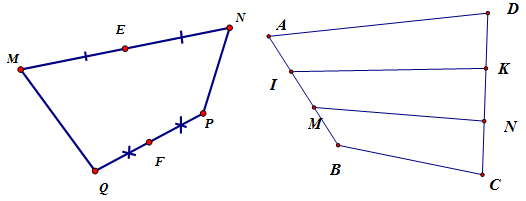
Bước 1:
Ta chứng minh bài toán sau:
Gọi \(E\), \(F\) lần lượt là trung điểm của \(MN\), \(PQ\) thì ta có: \(\overrightarrow {EF} = \dfrac{1}{2}\left( {\overrightarrow {MQ} + \overrightarrow {NP} } \right)\).
Thật vậy, ta có: $\overrightarrow {EF} = \dfrac{1}{2}\left( {\overrightarrow {EP} + \overrightarrow {EQ} } \right)$\( = \dfrac{1}{2}\left( {\overrightarrow {EN} + \overrightarrow {NP} + \overrightarrow {EM} + \overrightarrow {MQ} } \right)\)\( = \dfrac{1}{2}\left( {\overrightarrow {MQ} + \overrightarrow {NP} } \right)\)
Bước 2:
Gọi \(I\), \(K\) lần lượt là trung điểm của \(AM\) và \(DN\).
\( \Rightarrow \overrightarrow {IK} = \dfrac{1}{2}\left( {\overrightarrow {AD} + \overrightarrow {MN} } \right)\)
Bước 3:
Khi đó M là trung điểm của IB và N là trung điểm của KC.
Áp dụng kết quả của bài toán trên ta có: \(\overrightarrow {MN} = \dfrac{1}{2}\left( {\overrightarrow {BC} + \overrightarrow {IK} } \right)\)\( = \dfrac{1}{2}\left( {\overrightarrow {BC} + \dfrac{1}{2}\left( {\overrightarrow {AD} + \overrightarrow {MN} } \right)} \right)\)
\( = \dfrac{1}{2}\left( {\overrightarrow {BC} + \dfrac{1}{2}\overrightarrow {AD} + \dfrac{1}{2}\overrightarrow {MN} } \right)\)\( = \dfrac{1}{2}\overrightarrow {BC} + \dfrac{1}{4}\overrightarrow {AD} + \dfrac{1}{4}\overrightarrow {MN} \)
\( \Rightarrow \dfrac{3}{4}\overrightarrow {MN} = \dfrac{1}{2}\overrightarrow {BC} + \dfrac{1}{4}\overrightarrow {AD} \)
\( \Rightarrow \overrightarrow {MN} = \dfrac{1}{3}\overrightarrow {AD} + \dfrac{2}{3}\overrightarrow {BC} \).
Cho \(\Delta ABC\). Gọi \(M\), \(N\) là các điểm thỏa mãn: \(\overrightarrow {MA\,} + \overrightarrow {MB\,} = \overrightarrow {0\,} \), \(2\overrightarrow {NA\,} + 3\overrightarrow {NC} = \overrightarrow {0\,} \) và \(\overrightarrow {BC\,} = k\overrightarrow {BP\,} \). Tìm \(k\) để ba điểm \(M\), \(N\), \(P\) thẳng hàng.

Cách 1: Tự luận:
Ta có \(\overrightarrow {MN} = \overrightarrow {AN} - \overrightarrow {AM} = \dfrac{3}{5}\overrightarrow {AC} - \dfrac{1}{2}\overrightarrow {AB} \)\(\left( 1 \right)\)
\(\overrightarrow {NP} = \overrightarrow {NC} + \overrightarrow {CP} = \dfrac{2}{5}\overrightarrow {AC} + \left( {\overrightarrow {BP} - \overrightarrow {BC} } \right)\)
\( = \dfrac{2}{5}\overrightarrow {AC} + \left( {\dfrac{1}{k} - 1} \right)\overrightarrow {BC} \)
\( = \dfrac{2}{5}\overrightarrow {AC} + \left( {\dfrac{1}{k} - 1} \right)\left( {\overrightarrow {AC} - \overrightarrow {AB} } \right)\)
\( = \left( {\dfrac{1}{k} - \dfrac{2}{5}} \right)\overrightarrow {AC} - \left( {\dfrac{1}{k} - 1} \right)\overrightarrow {AB} \)
Để ba điểm \(M\), \(N\), \(P\) thẳng hàng thì $\exists m \in \mathbb{R}:\overrightarrow {NP} = m\overrightarrow {MN} $
\( \Leftrightarrow \left( {\dfrac{1}{k} - \dfrac{3}{5}} \right)\overrightarrow {AC} - \left( {\dfrac{1}{k} - 1} \right)\overrightarrow {AB} = \dfrac{{3m}}{5}\overrightarrow {AC} - \dfrac{m}{2}\overrightarrow {AB} \)
Điều kiện: \(\left\{ \begin{array}{l}\dfrac{1}{k} - \dfrac{3}{5} = \dfrac{{3m}}{5}\\ - \left( {\dfrac{1}{k} - 1} \right) = - \dfrac{m}{2}\end{array} \right.\)\( \Leftrightarrow \left\{ \begin{array}{l}m = 4\\k = \dfrac{1}{3}\end{array} \right.\).
Vậy \(k = \dfrac{1}{3}\).
Cách 2: Trắc nghiệm:
Ta có \(\overrightarrow {MA\,} + \overrightarrow {MB\,} = \overrightarrow {0\,} \Leftrightarrow \overrightarrow {MA\,} = - \overrightarrow {MB\,} \Rightarrow \dfrac{{\overline {MA} }}{{\overline {MB} }} = - 1\)
\(\overrightarrow {BC\,} = k\overrightarrow {BP\,} \Leftrightarrow \overrightarrow {PB\,} = \left( {1 - k} \right)\overrightarrow {PC\,} \Rightarrow \dfrac{{\overline {PB} }}{{\overline {PC} }} = 1 - k\)
\(2\overrightarrow {NA\,} + 3\overrightarrow {NC} = \overrightarrow {0\,} \Leftrightarrow 2\overrightarrow {NA\,} = - \dfrac{3}{2}\overrightarrow {NC\,} \Rightarrow \dfrac{{\overline {NA} }}{{\overline {NC} }} = - \dfrac{3}{2}\)
Theo định lí Mêlêxauýt ba điểm \(M\), \(N\), \(P\) thẳng hàng khi
\(\dfrac{{\overline {MA} }}{{\overline {MB} }} \cdot \dfrac{{\overline {PB} }}{{\overline {PC} }} \cdot \dfrac{{\overline {NC} }}{{\overline {NA} }} = 1\)\( \Leftrightarrow \left( { - 1} \right).\left( {1 - k} \right).\left( { - \dfrac{3}{2}} \right) = 1 \Leftrightarrow k = \dfrac{1}{3}\).
Vậy \(k = \dfrac{1}{3}\).
Cho hai véc tơ $\overrightarrow a $ và $\overrightarrow b $ thỏa mãn các điều kiện $\left| {\overrightarrow a } \right| = \dfrac{1}{2}\left| {\overrightarrow b } \right| = 1$,$\left| {\overrightarrow a - 2\overrightarrow b } \right| = \sqrt {15} $. Đặt $\overrightarrow u = \overrightarrow a + \overrightarrow b $ và $\overrightarrow v = 2k\overrightarrow a - \overrightarrow b $, $k \in \mathbb{R}$. Tìm tất cả các giá trị của $k$ sao cho $\left( {\overrightarrow u ,\overrightarrow v } \right) = 60^\circ $
$\left| {\overrightarrow a - 2\overrightarrow b } \right| = \sqrt {15} \Leftrightarrow {\left| {\overrightarrow a } \right|^2} + 4{\left| {\overrightarrow b } \right|^2} - 4\overrightarrow a \overrightarrow b = 15 \Leftrightarrow 2\overrightarrow a \overrightarrow b = 1$.
$\overrightarrow u \overrightarrow v = \left( {\overrightarrow a + \overrightarrow b } \right)\left( {2k\overrightarrow a - \overrightarrow b } \right) = 2k{\left| {\overrightarrow a } \right|^2} - {\left| {\overrightarrow b } \right|^2} + \left( {2k - 1} \right)\overrightarrow a \overrightarrow b = 2k - 4 + \dfrac{{2k - 1}}{2}$.
${\left( {\left| {\overrightarrow u } \right|\left| {\overrightarrow v } \right|} \right)^2} = {\left( {\left| {\left( {\overrightarrow a + \overrightarrow b } \right)} \right|\left| {\left( {2k\overrightarrow a - \overrightarrow b } \right)} \right|} \right)^2}$$ = \left( {{{\left| {\overrightarrow a } \right|}^2} + {{\left| {\overrightarrow b } \right|}^2} + 2\overrightarrow a \overrightarrow b } \right)\left( {4{k^2}{{\left| {\overrightarrow a } \right|}^2} + {{\left| {\overrightarrow b } \right|}^2} - 4k\overrightarrow a \overrightarrow b } \right)$$ = \left( {5 + 2\overrightarrow a \overrightarrow b } \right)\left( {4{k^2} + 4 - 4k\overrightarrow a \overrightarrow b } \right)$$ = 6\left( {4{k^2} + 4 - 2k} \right)$$ \Rightarrow \left| {\overrightarrow u } \right|\left| {\overrightarrow v } \right| = \sqrt {6\left( {4{k^2} + 4 - 2k} \right)} $.
$\left( {\overrightarrow u ,\overrightarrow v } \right) = 60^\circ $$ \Rightarrow \cos \left( {60^\circ } \right) = \dfrac{{\overrightarrow u \overrightarrow v }}{{\left| {\overrightarrow u } \right|\left| {\overrightarrow v } \right|}}$$ \Leftrightarrow \dfrac{1}{2} = \dfrac{{2k - 4 + \dfrac{{2k - 1}}{2}}}{{\sqrt {6\left( {4{k^2} + 4 - 2k} \right)} }}$$ \Leftrightarrow \sqrt {6\left( {4{k^2} + 4 - 2k} \right)} = 6k - 9$
$ \Leftrightarrow \sqrt {6\left( {4{k^2} + 4 - 2k} \right)} = 6k - 9$$ \Leftrightarrow \left\{ \begin{array}{l}k \ge \dfrac{3}{2}\\\sqrt {6\left( {4{k^2} + 2 - k} \right)} = 6k - 9\end{array} \right.$$ \Leftrightarrow \left\{ \begin{array}{l}k \ge \dfrac{3}{2}\\12{k^2} - 96k + 57 = 0\end{array} \right.$$ \Leftrightarrow \left\{ \begin{array}{l}k \ge \dfrac{3}{2}\\k = 4 \pm \dfrac{{3\sqrt 5 }}{2}\end{array} \right.$$ \Leftrightarrow k = 4 + \dfrac{{3\sqrt 5 }}{2}$.
Cho tứ giác $ABCD$, trên cạnh $AB$, $CD$ lấy lần lượt các điểm $M$, $N$ sao cho $3\,\overrightarrow {AM} = 2\,\overrightarrow {AB} $ và $3\,\overrightarrow{DN} = 2\,\overrightarrow {DC} $. Tính vectơ $\overrightarrow {MN} $ theo hai vectơ $\overrightarrow {AD} $, $\overrightarrow {BC} $.
Ta có $\overrightarrow {MN} = \overrightarrow {MA} + \overrightarrow {AD} + \overrightarrow {DN} $$ = \dfrac{2}{3}\overrightarrow {BA} + \overrightarrow {AD} + \dfrac{2}{3}\overrightarrow {DC} $
$ = \dfrac{2}{3}\left( {\overrightarrow {BC} + \overrightarrow {CA} } \right) + \overrightarrow {AD} + \dfrac{2}{3}\left( {\overrightarrow {DA} + \overrightarrow {AC} } \right)$$ = \dfrac{2}{3}\overrightarrow {BC} + \overrightarrow {AD} - \dfrac{2}{3}\overrightarrow {AD} $$ = \dfrac{1}{3}\overrightarrow {AD} + \dfrac{2}{3}\overrightarrow {BC} $.
Trong hệ tọa độ \(Oxy\), cho hai điểm \(A\left( {2; - 3} \right)\), \(B\left( {3; - 4} \right)\). Tìm tọa độ điểm \(M\) trên trục hoành sao cho chu vi tam giác $AMB$ nhỏ nhất.
Cách 1: Do \(M\) trên trục hoành $ \Rightarrow M\left( {x;0} \right)$, $\overrightarrow {AB} = \left( {1; - 1} \right)$$ \Rightarrow AB = \sqrt 2 $.
$\overrightarrow {AM} = \left( {x - 2;3} \right)$, $\overrightarrow {BM} = \left( {x - 3;4} \right)$
Ta có chu vi tam giác $AMB$: ${P_{ABM}} = \sqrt 2 + \sqrt {{{\left( {x - 2} \right)}^2} + {3^2}} + \sqrt {{{\left( {x - 3} \right)}^2} + {4^2}} $
$ = \sqrt 2 + \sqrt {{{\left( {x - 2} \right)}^2} + {3^2}} + \sqrt {{{\left( {3 - x} \right)}^2} + {4^2}} $$ \ge \sqrt 2 + \sqrt {{{\left( {x - 2 + 3 - x} \right)}^2} + {{\left( {3 + 4} \right)}^2}} $
$ \Leftrightarrow {P_{ABM}} \ge 6\sqrt 2 $. Dấu bằng xảy ra khi $\dfrac{{x - 2}}{{3 - x}} = \dfrac{3}{4}$$ \Leftrightarrow x = \dfrac{{17}}{7}$\( \Rightarrow M\left( {\dfrac{{17}}{7};0} \right)\).
Cách 2: Lấy đối xứng $A$ qua $Ox$ ta được $A'\left( {2;3} \right)$. Ta có $MA + MB = MA' + MB \ge A'B$.
Dấu bằng xảy ra khi $M$ trùng với giao điểm của $A'B$ với $Ox$.
Cho \(M\left( { - 1;\, - 2} \right)\), \(N\left( {3;\,2} \right)\), $P\left( {4;\, - 1} \right)$. Tìm $E$ trên $Ox$ sao cho \(\left| {\overrightarrow {EM} + \overrightarrow {EN} + \overrightarrow {EP} } \right|\) nhỏ nhất.
Do $E \in Ox$ $ \Rightarrow E\left( {a;\,0} \right)$.
Ta có: $\overrightarrow {EM\,} = \left( { - 1 - a;\, - 2} \right)$; $\overrightarrow {EN\,} = \left( {3 - a;\,2} \right)$; $\overrightarrow {EP\,} = \left( {4 - a;\, - 1} \right)$
Suy ra \(\overrightarrow {EM} + \overrightarrow {EN} + \overrightarrow {EP} = \left( {6 - 3a;\, - 1} \right)\).
Do đó: $\left| {\overrightarrow {EM} + \overrightarrow {EN} + \overrightarrow {EP} } \right| = \sqrt {{{\left( {6 - 3a} \right)}^2} + {{\left( { - 1} \right)}^2}} $$ = \sqrt {{{\left( {6 - 3a} \right)}^2} + 1} \ge 1$.
Giá trị nhỏ nhất của $\left| {\overrightarrow {EM} + \overrightarrow {EN} + \overrightarrow {EP} } \right|$ bằng $1$.
Dấu xảy ra khi và chỉ khi $6 - 3a = 0$ $ \Leftrightarrow a = 2$.
Vậy $E\left( {2;0} \right)$.
Cho tam giác \(ABC\). Tập hợp những điểm \(M\) sao cho: \(\left| {\overrightarrow {MA} + 2\overrightarrow {MB} } \right| = 6\left| {\overrightarrow {MA} - \overrightarrow {MB} } \right|\) là
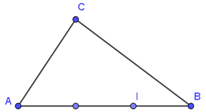
Gọi \(I\) là điểm trên cạnh \(AB\) sao cho \(3\overrightarrow {BI} = \overrightarrow {BA} \), ta có:
$\overrightarrow {MA} + 2\overrightarrow {MB} $$ = \overrightarrow {MB} + \overrightarrow {BA} + 2\overrightarrow {MB} $$ = 3\overrightarrow {MB} + \overrightarrow {BA} $$ = 3\overrightarrow {MB} + 3\overrightarrow {BI} $\( = 3\overrightarrow {MI} \).
\(\overrightarrow {MA} - \overrightarrow {MB} = \overrightarrow {BA} \).
\(\left| {\overrightarrow {MA} + 2\overrightarrow {MB} } \right| = 6\left| {\overrightarrow {MA} - \overrightarrow {MB} } \right|\) \( \Leftrightarrow \left| {3\overrightarrow {MI} } \right| = 6\left| {\overrightarrow {BA} } \right|\) \( \Leftrightarrow MI = 2AB\).
Vậy \(M\) nằm trên đường tròn tâm \(I\), bán kính \(R = 2AB\) với \(I\) nằm trên cạnh \(AB\) sao cho \(IA = 2IB\).
Cho tam giác \(ABC\). Gọi \(M\) là điểm được xác định: \(4\overrightarrow {BM} - 3\overrightarrow {BC} = \overrightarrow 0 \). Khi đó vectơ \(\overrightarrow {AM} \) bằng
Ta có: \(4\overrightarrow {BM} - 3\overrightarrow {BC} = \overrightarrow 0 \) \( \Leftrightarrow 4\left( {\overrightarrow {AM} - \overrightarrow {AB} } \right) - 3\left( {\overrightarrow {AC} - \overrightarrow {AB} } \right) = \overrightarrow 0 \)
\( \Leftrightarrow 4\overrightarrow {AM} - 4\overrightarrow {AB} - 3\overrightarrow {AC} + 3\overrightarrow {AB} = \overrightarrow 0 \) \( \Leftrightarrow \overrightarrow {AM} = \dfrac{1}{4}\overrightarrow {AB} + \dfrac{3}{4}\overrightarrow {AC} \).
Tam giác $ABC$ thỏa mãn: $\left| {\overrightarrow {AB} + \overrightarrow {AC} } \right| = \left| {\overrightarrow {AB} - \overrightarrow {AC} } \right|$ thì tam giác \(ABC\) là
Gọi $M$ là trung điểm $BC$.
Ta có $\left| {\overrightarrow {AB} + \overrightarrow {AC} } \right| = \left| {\overrightarrow {AB} - \overrightarrow {AC} } \right|$ $ \Leftrightarrow \left| {2\overrightarrow {AM} } \right| = \left| {\overrightarrow {CB} } \right| \Leftrightarrow AM = \dfrac{1}{2}BC$.
Trung tuyến kẻ từ $A$ bằng một nửa cạnh $BC$ nên tam giác $ABC$ vuông tại $A$.
Trong mặt phẳng tọa độ $Oxy$, tọa độ điểm $N$ trên cạnh $BC$ của tam giác $ABC$ có $A\left( {1; - 2} \right)$, $B\left( {2;3} \right)$, $C\left( { - 1; - 2} \right)$ sao cho ${S_{ABN}} = 3{S_{ANC}}$ là
Gọi \(H\) là chân đường cao kẻ từ \(A\) của tam giác \(ABC\).
Theo đề ta có: \({S_{ABN}} = 3{S_{ACN}}\) \( \Leftrightarrow \dfrac{1}{2}AH.BN = \dfrac{3}{2}AH.CN\) \( \Leftrightarrow BN = 3CN\)
\( \Leftrightarrow \overrightarrow {BN} = - 3\overrightarrow {CN} \Leftrightarrow \overrightarrow {BN} = - 3\left( {\overrightarrow {BN} - \overrightarrow {BC} } \right) \Leftrightarrow 4\overrightarrow {BN} = 3\overrightarrow {BC} \;\left( * \right)\).
Ta có \(\overrightarrow {BN} = \left( {{x_N} - 2;{y_N} - 3} \right)\); \(\overrightarrow {BC} = \left( { - 3; - 5} \right)\).
Do đó \(\left( * \right) \Leftrightarrow \left\{ \begin{array}{l}4\left( {{x_N} - 2} \right) = 3\left( { - 3} \right)\\4\left( {{y_N} - 3} \right) = 3\left( { - 5} \right)\end{array} \right. \Leftrightarrow \left\{ \begin{array}{l}{x_N} = - \dfrac{1}{4}\\{y_N} = - \dfrac{3}{4}\end{array} \right.\). Vậy \(N\left( { - \dfrac{1}{4}; - \dfrac{3}{4}} \right)\).
Cho hình thang $ABCD$ có đáy $AB = a$, $CD = 2a$. Gọi $M$, $N$ lần lượt là trung điểm $AD$ và $BC$. Tính độ dài của véctơ $\overrightarrow {MN} + \overrightarrow {BD} + \overrightarrow {CA} $.
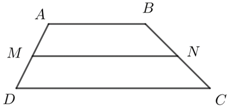
Ta có $M,\,N$ là trung điểm của $AD$ và $BC$ nên $\overrightarrow {MD} + \overrightarrow {MA} = \overrightarrow 0 $ và $\overrightarrow {BN} + \overrightarrow {CN} = \overrightarrow 0 $.
Khi đó: $\left| {\overrightarrow {MN} + \overrightarrow {BD} + \overrightarrow {CA} } \right| = \left| {\overrightarrow {MN} + \overrightarrow {BN} + \overrightarrow {NM} + \overrightarrow {MD} + \overrightarrow {CN} + \overrightarrow {NM} + \overrightarrow {MA} } \right|$
$ = \left| {\overrightarrow {MN} + 2\overrightarrow {NM} } \right| = \left| {\overrightarrow {NM} } \right| = NM = \dfrac{1}{2}\left( {AB + CD} \right) = \dfrac{{3a}}{2}$.
Trên mặt phẳng tọa độ $Oxy$, cho $\Delta ABC$ vuông tại $A$ có $B \left( {1\,;\, - 3} \right)$ và $C \left( {1\,;\,2} \right)$. Tìm tọa độ điểm $H$ là chân đường cao kẻ từ đỉnh $A$ của $\Delta ABC$, biết $AB = 3$, $AC = 4$.
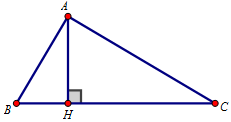
Ta có $A{B^2} = BH.BC$ và $A{C^2} = CH.CB$. Do đó: $\dfrac{{CH}}{{BH}} = \dfrac{{A{C^2}}}{{A{B^2}}} = \dfrac{{16}}{9}$ $ \Rightarrow HC = \dfrac{{16}}{9}.HB$.
Mà $\overrightarrow {HC} ,\overrightarrow {HB} $ ngược hướng nên $\overrightarrow {HC} = - \dfrac{{16}}{9}\overrightarrow {HB} $.
Khi đó, gọi $H\left( {x;y} \right)$ thì $\overrightarrow {HC} = \left( {1 - x\,;2 - y} \right)$, $\overrightarrow {HB} = \left( {1 - x\,; - 3 - y} \right)$.
Suy ra: $\left\{ \begin{array}{l}1 - x = - \dfrac{{16}}{9}\left( {1 - x} \right)\\2 - y = - \dfrac{{16}}{9}\left( { - 3 - y} \right)\end{array} \right.$ $ \Leftrightarrow \left\{ \begin{array}{l}x = 1\\y = - \dfrac{6}{5}\end{array} \right.$ $ \Leftrightarrow H\left( {1\,;\, - \dfrac{6}{5}} \right)$.
Trong mặt phẳng $Oxy$, cho tam giác \(MNP\) có \(M\left( {1;{\rm{ }} - 1} \right)\), \(N\left( {5;{\rm{ }} - 3} \right)\) và \(P\) là điểm thuộc trục \(Oy\), trọng tâm \(G\) của tam giác \(MNP\) nằm trên trục \(Ox\). Tọa độ điểm \(P\) là
\(P \in Oy \Rightarrow P\left( {0;{\rm{ }}y} \right)\).
\(G \in Ox \Rightarrow G\left( {x;{\rm{ 0}}} \right)\).
Điểm \(G\) là trọng tâm của tam giác \(MNP\) \( \Leftrightarrow \left\{ \begin{array}{l}x = \dfrac{{1 + 5 + 0}}{3}\\0 = \dfrac{{\left( { - 1} \right) + \left( { - 3} \right) + y}}{3}\end{array} \right.\)
\( \Leftrightarrow \left\{ \begin{array}{l}x = 2\\y = 4\end{array} \right.\)
$ \Rightarrow P\left( {0;4} \right),G\left( {2;0} \right)$
Cho hai lực \(\overrightarrow {{F_1}} = \overrightarrow {MA} \), \(\overrightarrow {{F_2}} = \overrightarrow {MB} \) cùng tác động vào một vật tại điểm \(M\) cường độ hai lực $\overrightarrow {{F_1}} $, $\overrightarrow {{F_2}} $ lần lượt là \(300\left( {\rm{N}} \right)\) và \(400\left( {\rm{N}} \right)\). \(\widehat {AMB} = 90^\circ \). Tìm cường độ của lực tổng hợp tác động vào vật.
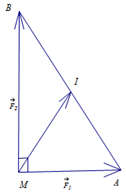
Cường độ lực tổng hợp của $\left| {\overrightarrow F } \right| = \left| {\overrightarrow {{F_1}} + {{\overrightarrow F }_2}} \right|$$ = \left| {\overrightarrow {MA} + \overrightarrow {MB} } \right|$$ = 2\left| {\overrightarrow {MI} } \right| = AB$ (\(I\) là trung điểm của \(AB\)). Ta có \(AB = \sqrt {M{A^2} + M{B^2}} = 500\) suy ra \(\left| {\overrightarrow F } \right| = 500\,\left( N \right)\).
Cho tam giác $ABC$, $M$ và $N$ là hai điểm thỏa mãn: $\overrightarrow {BM} = \overrightarrow {BC} - 2\overrightarrow {AB} $, $\overrightarrow {CN} = x\overrightarrow {AC} - \overrightarrow {BC} $. Xác định \(x\) để $A$, $M$, $N$ thẳng hàng
Ta có
$\begin{array}{l}\overrightarrow {BM} = \overrightarrow {BC} - 2\overrightarrow {AB} \Leftrightarrow \overrightarrow {AM} \,\, = \overrightarrow {BC} \, - \overrightarrow {AB} \Leftrightarrow \overrightarrow {AM} = - \overrightarrow {AC} + 2\overrightarrow {BC} \\\overrightarrow {CN} = x\overrightarrow {AC} - \overrightarrow {BC} . \Leftrightarrow \overrightarrow {CA} + \overrightarrow {AN} = x\overrightarrow {AC} - \overrightarrow {BC} \Leftrightarrow \overrightarrow {AN} = \left( {x + 1} \right)\overrightarrow {AC} - \overrightarrow {BC} \end{array}$
Để $A,{\rm{ }}M,{\rm{ }}N$ thẳng hàng thì \(\exists k \ne 0\) sao cho \(\overrightarrow {AM} = k\overrightarrow {AN} \)
Hay $\left( {x + 1} \right)\overrightarrow {AC} - \overrightarrow {BC} = k\left( { - \overrightarrow {AC} + 2\overrightarrow {BC} } \right) \Leftrightarrow \left\{ \begin{array}{l}x + 1 = - k\\ - 1 = 2k\end{array} \right. \Leftrightarrow \left\{ \begin{array}{l}k = \dfrac{{ - 1}}{2}\\x = \dfrac{{ - 1}}{2}\end{array} \right.$
Cho $\Delta ABC$. Tìm tập hợp các điểm $M$ sao cho: $\left| {\overrightarrow {MA} + 3\overrightarrow {MB} - 2\overrightarrow {MC} } \right| = \left| {2\overrightarrow {MA} - \overrightarrow {MB} - \overrightarrow {MC} } \right|$.

Gọi $I$ là điểm thỏa mãn $\overrightarrow {IA} + 3\overrightarrow {IB} - 2\overrightarrow {IC} = \overrightarrow 0 $.
$\left| {\overrightarrow {MA} + 3\overrightarrow {MB} - 2\overrightarrow {MC} } \right| = \left| {2\overrightarrow {MA} - \overrightarrow {MB} - \overrightarrow {MC} } \right|$$ \Leftrightarrow \left| {2\overrightarrow {MI} + \overrightarrow {IA} + 3\overrightarrow {IB} - 2\overrightarrow {IC} } \right| = \left| {\overrightarrow {BA} + \overrightarrow {CA} } \right|$ $\left( 1 \right)$.
Gọi $N$ là trung điểm $BC$. Ta được: $\left( 1 \right) \Leftrightarrow 2\left| {\overrightarrow {MI} } \right| = 2\left| { - \overrightarrow {AN} } \right| \Leftrightarrow IM = AN$.
$I$, $A$, $N$ cố định nên tập hợp các điểm $M$ là đường tròn tâm $I$, bán kính $AN$.
Tam giác $ABC$ là tam giác nhọn có $AA'$ là đường cao.
Khi đó véctơ $\overrightarrow u = \left( {\tan B} \right)\overrightarrow {A'B} + \left( {\tan C} \right)\overrightarrow {A'C} $ là

$\overrightarrow u = \left( {\tan B} \right)\overrightarrow {A'B} + \left( {\tan C} \right) \overrightarrow {A'C} $ $ \Leftrightarrow \overrightarrow u = \dfrac{{AA'}}{{BA'}}\overrightarrow {A'B} + \dfrac{{AA'}}{{CA'}}\overrightarrow {A'C} $.
Ta thấy hai vecto $\dfrac{{AA'}}{{BA'}}\overrightarrow {A'B} $ và $\dfrac{{AA'}}{{CA'}}\overrightarrow {A'C} $ ngược hướng và độ dài mỗi vecto bằng $AA'$ nên chúng là hai vecto đối nhau.
Vậy $\overrightarrow u = \overrightarrow 0 $.

